Tommy Bolack Profile
Reprinted from "Crown Jewels of the Wire", December 2004, page 32
Tommy Bolack holds an extremely rare CD 317.8, one of the prizes in his
collection. Tommy is essentially a CD collector, seeking foreign as well as
North American glass insulators. But he also enjoys outstanding examples of some
of the more common CD's, such as the purple CD 126.4 below.


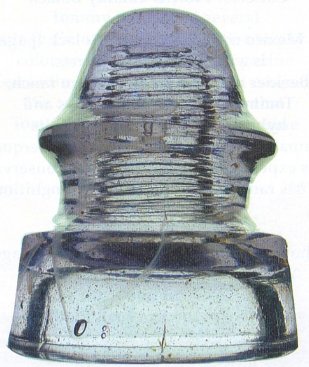
See pages 38 - 39 for descriptions of these Crown Jewels
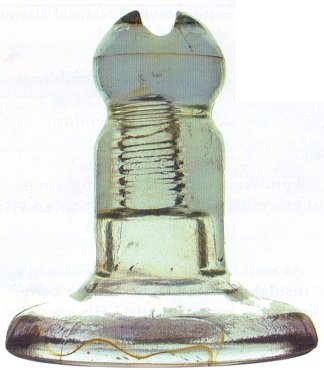
(page 33)
Collector Profile: Tommy Bolack
New Mexico collector Tommy Bolack (page 32) is a man of many interests.
Besides managing a 10,000 acre ranch, Tommy grows specialty crops and hybrid plants which he exhibits annually at the State Fair in Albuquerque.
He has
expended great effort in soil conservation on his ranch, earning national
recognition.
A view of Tommy's ranch is shown behind the text of these two
pages.
You are looking down from a bluff hundreds of feet above the fertile valley of
the San Juan River.
On the ranch are a couple of outstanding museums. One is perhaps the nicest
privately owned Natural History museum around.
Tommy also has two large buildings stocked with every kind of electro-magnetic
invention you can imagine.
Admission is free to both museums, but you must call ahead to schedule a visit.
(see pages 18 & 19)
As well known as Tommy is among insulator collectors, he may be better known as
a numismatics. His specialty in coin collecting: US error coins.
Over the years Tommy has issued several grants to Crown Jewels of the Wire to
pay for color printing inside the magazine (excluding color advertising, of
course).
We are pleased to announce that Tommy has presented the magazine with
another grant, one that should cover the cost of color printing through all of
2005.
In this issue, we share color pictures of Tommy's crown jewels.
Descriptions are on pages 38 & 39.
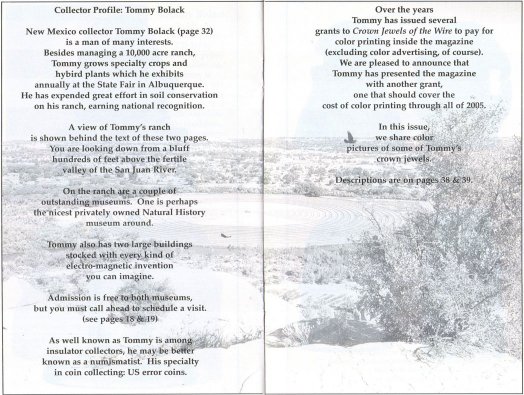
Large Image (406 Kb)
(pages 34 & 35)
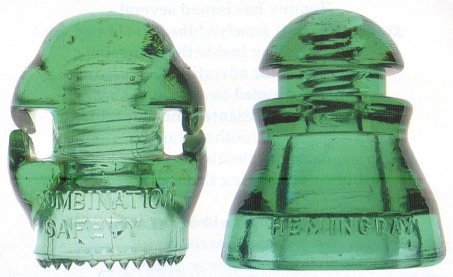
See pages 38 & 39 for descriptions of these tough CD's.
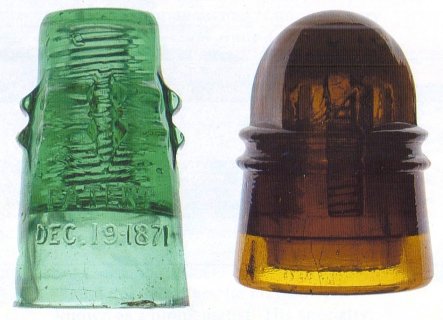
(page 36)
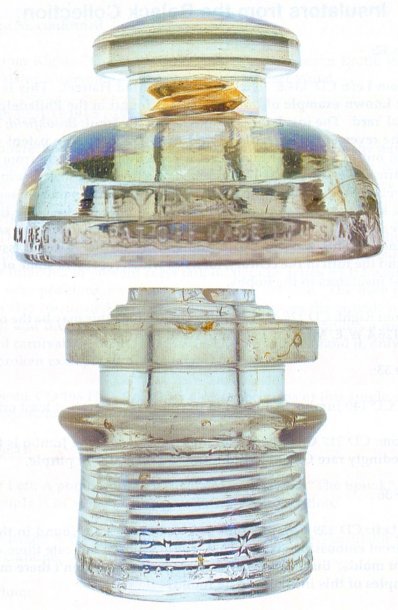
PYREX CD 194.5/195.5
Depicted here in actual size, this may be the only
unbroken example of this
transposition known to the hobby.
See details on page 39.
(page 37)
Insulators from the Bolack Collection:
Page 32:
Bottom Left: CD 134.6. Nicknamed the "Mad Hatter". This is the only
known example of this CD. It was found in the Philadelphia Naval Yard. The
insulator is embossed on the front: Brookfield; and on the reverse: Philadelphia
/ Pat'd April 17, 1896. The patent was taken out by Hannibal Rappleye. A
contemporary article from the Electrical Review in 1897 described the insulator
has having a '"novel method of tying line wire".... "The tie, in its
operation, seems to be similar to the stopper device used on beer bottles. The
tie is made instantly, by the snap of the lever, or is unmade in the same
manner".* This was one of a number of "no tie" patents issued around
the turn of the century, many of which represent some of the rarest insulators
in the hobby.
Bottom Right: CD 126.4. A Hemingray product, this may be the only CD 126.4
W.E. Mfg. Co known in royal purple.
Page 33:
Top: CD 140 Jumbo. A Jumbo in purple? Yes, there's at least one.
Bottom: CD 317 Chambers: Not to be outdone by the Jumbo is this exceedingly
rare Chamber lightning rod insulator in purple.
Page 36:
Top Left: CD 139 Combination Safety. CD 139's are found in three different
embossing styles. That would seem to indicate three different molds. But if
three molds were made, why aren't there more examples of this insulator to be
found?
Top Right: CD 155.6 Hemingray. An experimental insulator, it looks like
Hemingray tried to put the top of a CD 128 on the base of a CD 155.
Bottom Left: CD 130.2 Seiler's Patent. Paul Seiler's involvement in telegraph
development was widespread throughout the American West. So why haven't more CD
130.2's surfaced?
(page 38)
Page 36, continued
Bottom Right: CD 158.2 Boston "barrel". No Boston Bottle Works insulator
is common. But a "barrel" in amber? Wow!
Page 37: CD 194.5 / 195.5
The rarest of all two piece transpositions is also one of the newest. Made
experimentally by Pyrex, this item was patented on June 3, 1930. The patent was
assigned to the American Telephone and Telegraph Company. According to the book,
A History and Guide to North American Glass Pin type Insulators, by John and
Carol' McDougald, the base piece was designed to fit snugly into the top to form
a water tight joint. Like other transpositions, the insulator was intended to
prevent cross talk on parallel wires by transposing the wire positions a various
points along the line. The base piece was also corrugated to increase the path
between the outside of the skirt and the pin, helping to insulate better. The
top has a hint of light carnival, while the base is clear. As we understand it,
only one unbroken example of this insulator is known.
Page 40: CD 196 H.G. Co. Only a few specimens of this single piece
transposition are known in purple coloration.
Page 41:
Top Left: A popular foreign insulator nicknamed "The Spook", this
example is in an outstanding yellow green coloration.
Top Right: A vivid blue (is it cobalt? peacock blue?) insulator from the
Ukraine.
Bottom:
CD 699: This French made insulator is nick-named "The Frog" due to its
shape. Tommy says this is one of his favorite insulators.
References:
*Insulators, A History and Guide to North American Glass Pintype
Insulators,
by John & Carol McDougald, 1990.
(page 39)
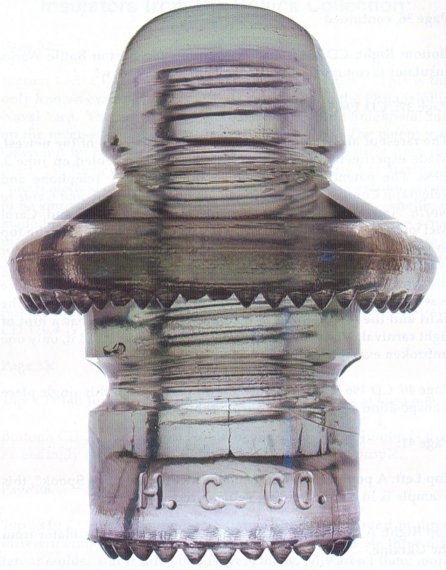
THIS CD 196 H.G. CO. TRANSPOSITION IN LIGHT PURPLE IS SHOWN
IN ACTUAL SIZE SO
YOU CAN FULLY ENJOY THE BEAUTY OF THIS
EXCEEDINGLY SCARCE CROWN JEWEL OF THE
WIRE.
(page 40)
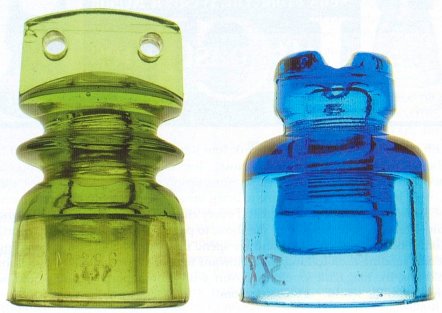
COLORFUL FOREIGN IN INTERESTING SHAPES
See descriptions on pages 38 - 39
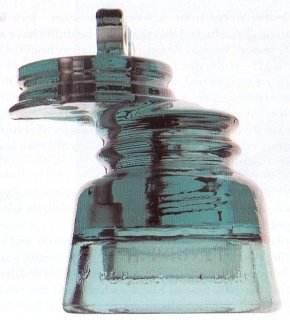
(page 41)
| 